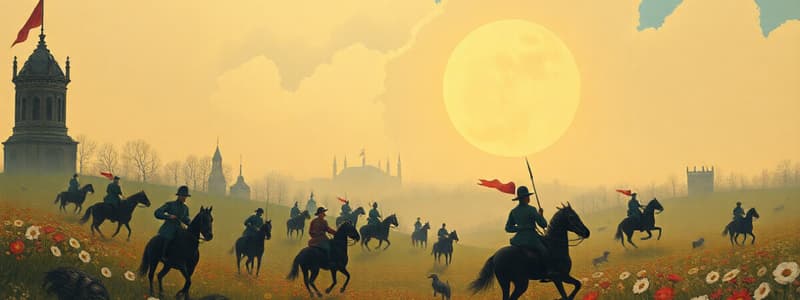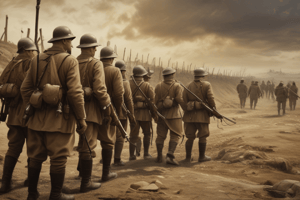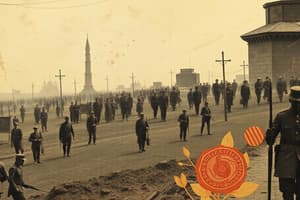Podcast
Questions and Answers
What was the primary goal of the Battle of the Somme?
What was the primary goal of the Battle of the Somme?
- To capture Paris
- To end the war quickly
- To test new tank technology
- To divert German attention from Verdun (correct)
Approximately how many casualties resulted from the Battle of the Somme?
Approximately how many casualties resulted from the Battle of the Somme?
- 500,000
- 1 million
- 800,000 (correct)
- 2 million
What psychological condition affected many soldiers due to constant bombardment?
What psychological condition affected many soldiers due to constant bombardment?
- Post-traumatic stress disorder
- Gangrene
- Shell shock (correct)
- Trench foot
Which new weapon blinded, burned, and choked soldiers in the trenches?
Which new weapon blinded, burned, and choked soldiers in the trenches?
How did the Allies defend against U-boat attacks?
How did the Allies defend against U-boat attacks?
What was 'No Man's Land' in World War I?
What was 'No Man's Land' in World War I?
Which of the following was a major naval battle during World War I?
Which of the following was a major naval battle during World War I?
The Lusitania, sunk by a German submarine, was what type of ship?
The Lusitania, sunk by a German submarine, was what type of ship?
The term 'Stalemate' refers to what aspect of World War I?
The term 'Stalemate' refers to what aspect of World War I?
What was the main purpose of the League of Nations?
What was the main purpose of the League of Nations?
What did the term 'total war' in World War I mean?
What did the term 'total war' in World War I mean?
Who were the 'Central Powers' during World War I?
Who were the 'Central Powers' during World War I?
Which treaty ended the war between which two countries?
Which treaty ended the war between which two countries?
What was a result of the Battle of the Somme?
What was a result of the Battle of the Somme?
Who were the 'Doughboys' during World War I?
Who were the 'Doughboys' during World War I?
What was the primary reason for Austria-Hungary's anger towards Serbia?
What was the primary reason for Austria-Hungary's anger towards Serbia?
How did family relationships between European monarchs affect the outbreak of war?
How did family relationships between European monarchs affect the outbreak of war?
What was the significance of the Dardanelles for Russia?
What was the significance of the Dardanelles for Russia?
How did the assassination of Franz Ferdinand affect Austria-Hungary's approach to Serbia?
How did the assassination of Franz Ferdinand affect Austria-Hungary's approach to Serbia?
What was the main flaw in the Schlieffen Plan?
What was the main flaw in the Schlieffen Plan?
Who was the leader of Germany during World War I?
Who was the leader of Germany during World War I?
Which of the following countries switched sides during World War I?
Which of the following countries switched sides during World War I?
What type of warfare was primarily used on the Western Front?
What type of warfare was primarily used on the Western Front?
What was a main reason the United States entered World War I?
What was a main reason the United States entered World War I?
What was the outcome of the Battle of Gallipoli?
What was the outcome of the Battle of Gallipoli?
What were 'dogfights' during World War I?
What were 'dogfights' during World War I?
Which weapon was first used extensively in World War I?
Which weapon was first used extensively in World War I?
What was the role of women in World War I?
What was the role of women in World War I?
What was the Treaty of Versailles?
What was the Treaty of Versailles?
Which of the following was NOT a new technology used in World War I?
Which of the following was NOT a new technology used in World War I?
What was the main purpose of Zeppelins during World War I?
What was the main purpose of Zeppelins during World War I?
How did the nature of warfare change during World War I?
How did the nature of warfare change during World War I?
Which event is considered the immediate cause of World War I?
Which event is considered the immediate cause of World War I?
Which countries were part of the Triple Entente during World War I?
Which countries were part of the Triple Entente during World War I?
How did Serbia respond to Austria-Hungary's ultimatum following the assassination?
How did Serbia respond to Austria-Hungary's ultimatum following the assassination?
Why did Russia begin to mobilize its troops in support of Serbia?
Why did Russia begin to mobilize its troops in support of Serbia?
What was the Schlieffen Plan?
What was the Schlieffen Plan?
How did Britain become involved in the war?
How did Britain become involved in the war?
What was the 'Rape of Belgium'?
What was the 'Rape of Belgium'?
Which event directly triggered the start of World War I?
Which event directly triggered the start of World War I?
What was the main purpose of the alliances formed in Europe before WWI?
What was the main purpose of the alliances formed in Europe before WWI?
How did militarism contribute to the outbreak of WWI?
How did militarism contribute to the outbreak of WWI?
Which of the following was NOT a major alliance in pre-WWI Europe?
Which of the following was NOT a major alliance in pre-WWI Europe?
Why was the Balkan region often referred to as the 'powder keg of Europe'?
Why was the Balkan region often referred to as the 'powder keg of Europe'?
What factors contributed to the difficulties faced by Russian soldiers at the beginning of World War I?
What factors contributed to the difficulties faced by Russian soldiers at the beginning of World War I?
Which country made a shift from being part of the Central Powers to joining the Allies in 1915?
Which country made a shift from being part of the Central Powers to joining the Allies in 1915?
What strategic advantage did the Ottoman Empire provide to its allies during World War I?
What strategic advantage did the Ottoman Empire provide to its allies during World War I?
What was the result of the military campaign known as the Battle of Gallipoli?
What was the result of the military campaign known as the Battle of Gallipoli?
What catastrophic event is now recognized as the 'Armenian Genocide'?
What catastrophic event is now recognized as the 'Armenian Genocide'?
Flashcards
No Man's Land
No Man's Land
The area between opposing trenches in World War I, characterized by dangerous and deadly conditions.
Battle of Jutland
Battle of Jutland
A naval battle that took place in the North Sea during World War I between the British Royal Navy and the German Imperial Navy, resulting in a British victory.
Stalemate in World War I
Stalemate in World War I
The term "Stalemate" describes the situation in World War I where neither side could achieve a decisive victory, mainly due to the effectiveness of trench warfare.
Lusitania
Lusitania
Signup and view all the flashcards
League of Nations
League of Nations
Signup and view all the flashcards
The Battle of the Somme
The Battle of the Somme
Signup and view all the flashcards
Shell shock
Shell shock
Signup and view all the flashcards
Poison gas
Poison gas
Signup and view all the flashcards
Big Bertha
Big Bertha
Signup and view all the flashcards
Ship convoys
Ship convoys
Signup and view all the flashcards
Schlieffen Plan
Schlieffen Plan
Signup and view all the flashcards
Trench Warfare
Trench Warfare
Signup and view all the flashcards
Sinking of the Lusitania
Sinking of the Lusitania
Signup and view all the flashcards
What did 'Total War' mean in World War I?
What did 'Total War' mean in World War I?
Signup and view all the flashcards
Who were the 'Central Powers' in World War I?
Who were the 'Central Powers' in World War I?
Signup and view all the flashcards
Which treaty ended the war between Germany and Russia?
Which treaty ended the war between Germany and Russia?
Signup and view all the flashcards
What was the result of the Battle of the Somme?
What was the result of the Battle of the Somme?
Signup and view all the flashcards
Who were the 'Doughboys' in World War I?
Who were the 'Doughboys' in World War I?
Signup and view all the flashcards
What sparked Austria-Hungary's outrage towards Serbia?
What sparked Austria-Hungary's outrage towards Serbia?
Signup and view all the flashcards
What was the flaw in the Schlieffen Plan?
What was the flaw in the Schlieffen Plan?
Signup and view all the flashcards
How did family relationships influence the war's outbreak?
How did family relationships influence the war's outbreak?
Signup and view all the flashcards
Why was the Dardanelles important to Russia?
Why was the Dardanelles important to Russia?
Signup and view all the flashcards
How did technology make 'no man's land' deadly?
How did technology make 'no man's land' deadly?
Signup and view all the flashcards
What was the outcome of the Battle of Gallipoli?
What was the outcome of the Battle of Gallipoli?
Signup and view all the flashcards
What were 'dogfights' during World War I?
What were 'dogfights' during World War I?
Signup and view all the flashcards
Which weapon was first used extensively in World War I?
Which weapon was first used extensively in World War I?
Signup and view all the flashcards
What was the role of women in World War I?
What was the role of women in World War I?
Signup and view all the flashcards
What was the Treaty of Versailles?
What was the Treaty of Versailles?
Signup and view all the flashcards
Russian Military Weakness
Russian Military Weakness
Signup and view all the flashcards
Italy's Side Switch
Italy's Side Switch
Signup and view all the flashcards
Ottoman Empire's Strategic Value
Ottoman Empire's Strategic Value
Signup and view all the flashcards
Gallipoli Stalemate
Gallipoli Stalemate
Signup and view all the flashcards
Lawrence of Arabia
Lawrence of Arabia
Signup and view all the flashcards
Austria-Hungary's Ultimatum to Serbia
Austria-Hungary's Ultimatum to Serbia
Signup and view all the flashcards
Russia's Mobilization in Support of Serbia
Russia's Mobilization in Support of Serbia
Signup and view all the flashcards
What was the Schlieffen Plan?
What was the Schlieffen Plan?
Signup and view all the flashcards
Why did Britain Join WWI?
Why did Britain Join WWI?
Signup and view all the flashcards
What was the "Rape of Belgium"?
What was the "Rape of Belgium"?
Signup and view all the flashcards
What sparked the start of WWI?
What sparked the start of WWI?
Signup and view all the flashcards
How did the alliance system contribute to WWI?
How did the alliance system contribute to WWI?
Signup and view all the flashcards
What was the role of nationalism in the outbreak of WWI?
What was the role of nationalism in the outbreak of WWI?
Signup and view all the flashcards
Why was the Balkan region called the 'powder keg of Europe?'
Why was the Balkan region called the 'powder keg of Europe?'
Signup and view all the flashcards
What was the 'blank check' and its role in WWI?
What was the 'blank check' and its role in WWI?
Signup and view all the flashcards
What event sparked World War I?
What event sparked World War I?
Signup and view all the flashcards
Who formed the Triple Entente?
Who formed the Triple Entente?
Signup and view all the flashcards
Who formed the Triple Alliance?
Who formed the Triple Alliance?
Signup and view all the flashcards
How did World War I change warfare?
How did World War I change warfare?
Signup and view all the flashcards
What was the main purpose of Zeppelins in World War I?
What was the main purpose of Zeppelins in World War I?
Signup and view all the flashcards
Study Notes
World War 1 Key Concepts
- No Man's Land was the area between opposing trenches in a battle.
- The Battle of Jutland was a major naval battle in World War I.
- The Lusitania was a civilian passenger ship sunk by a German submarine
- Stalemate refers to a lack of progress in battles.
- Poison gas was a new weapon used in World War I.
- Tanks were a new technology introduced in World War I.
- The Battle of Verdun resulted in a stalemate and heavy casualties.
- The League of Nations aimed to promote international peace and cooperation.
- The Schlieffen Plan was a German plan to quickly defeat France before turning to Russia.
- The Ottoman Empire was known as the "Sick Man of Europe" before World War I.
- Zeppelins were used in World War I for long-range bombing.
- The Battle of the Somme resulted in high casualties and little territorial gain.
- Trenches were part of the stalemated war on the Western Front.
- "Big Bertha" was a German artillery piece.
- Shell Shock was a psychological condition caused by constant bombardment in trenches.
Studying That Suits You
Use AI to generate personalized quizzes and flashcards to suit your learning preferences.




